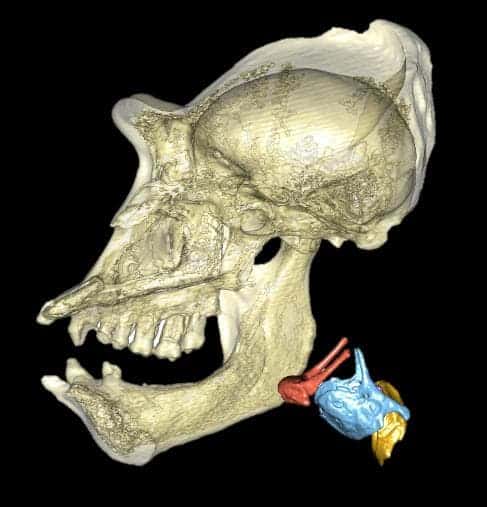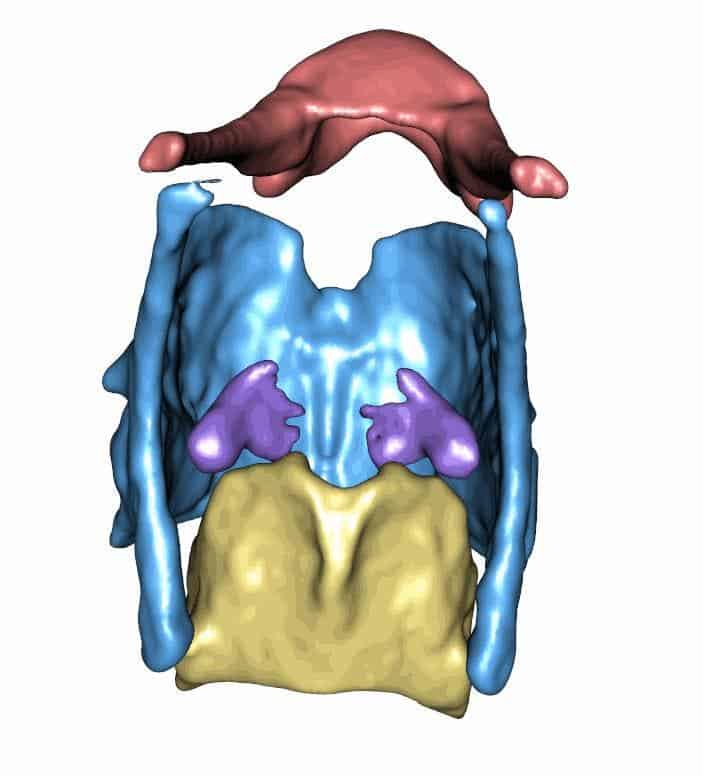
After more than a decade of putting together a large collection of animal larynxes, or voice boxes, an international team of researchers has uncovered some interesting patterns. According to the findings, the primate larynx is much larger relative to body size, has more variation, and evolves at a faster rate than that in other mammals.
The voice box protects the airways during feeding, regulates the air supply to the lungs, and is obviously paramount to vocal communication.
Due to its crucial role in vocalization, biologists have always suspected that the larynx is a key area of evolution. This ought to be particularly true in species known for their social behavior and complex vocal communication systems, chief among them being humans.
But that doesn’t mean we’re the only members of the animal kingdom with a big mouth.
For their new study, researchers at Anglia Ruskin University (ARU), Stanford University, and the University of Vienna, made CT scans for the larynxes of 55 mammalian species and later produced 3D computer models for each voice box.
Voice box measurements were compared to other indicators specific to each species, such as body length and mass.
The mammals included in the study ranged from the tiny pygmy marmoset (Cebuella pygmaea), which can weigh less than a smartphone, to the kingly Western gorilla (Gorilla gorilla), which can easily weigh 120 kg.
“Our research takes a broad comparative perspective, ranging from detailed descriptions of vocal anatomy, through to recording animal sounds, carrying out field experiments, and using statistical analyses to test evolutionary hypotheses,” co-author Dr. Jacob Dunn, Reader in Evolutionary Biology at Anglia Ruskin University (ARU), told ZME Science.
“All of the animals involved in our research died of natural causes in zoos – indeed most of us also work in animal conservation research,” he added.

Sourcing the larynxes for so many species proved quite challenging, especially when dealing with rare and exotic animals. It took more than 10 years to collect enough specimens and perform CT scans on them. And like all matters of life, rarely do things go as expected.
“One memorable moment was when I was travelling from Edinburgh to Vienna with several specimens in cool boxes. We had all the appropriate permits, etc., and, as I was unable to travel direct, I flew via Amsterdam. On arrival to Vienna, I went to pick up my luggage and only three out of four of the cool boxes had arrived. I then had to go and explain to the customs official that my missing luggage was a large cool box which contained a frozen jaguar torso! Fortunately, it arrived the next day – and all was well,” Dunn recounted.
According to the findings, primate larynxes are 38% larger, on average, than those of carnivorans. Their rate of larynx evolution is also much faster compared to non-primates.
When examined by their relative body size, primate larynges also exhibit more variation, whereas carnivorans have a more fixed larynx to body size ratio. This flexibility may explain why the rate of evolution is greater.
“It could be something to do with differences in the diet, or locomotion, between primates and other mammals – but this seems unlikely. It may be something to do with the fact that primates tend to live in forest environments, and a large larynx allows them to produce a low frequency call – which travels well in this habitat. It may also be something to do with their social life or mating systems. For example, in many primates males produce loud calls to compete for females or territories. However, we are not convinced that anyone of these hypotheses alone is enough to explain the differences we find. One thing that seems certain is that the greater variation and faster evolution of the primate larynx has meant that primates have been able to evolve a diverse range of uses of the larynx, and this evolutionary flexibility may help explain why we and other primates have developed complex and diverse uses of the vocal organ for communication,” Dunn told me in an email.
These differences in larynx size and rate of evolution highlight the voice box’s crucial role in vocal communication, which may explain why primates have such a rich and varied repertoire of vocal calls. However, the connection between these findings and the evolution of speech is unclear.
“We find it very interesting that human ancestors are found within the group which has evolved a larger, more variable larynx, which is under faster rates of evolution. Indeed, one of the complex and diverse uses of the vocal organ that we find amongst primates is speech. However, it is a big jump to say that our results can explain the evolution of language – which they cannot. All we can say is that we are a member of what looks to be an interesting group in terms of larynx evolution – one which shows a wide range of vocal communication, including soprano singing in gibbons, terrifying roaring in howler monkeys, ultrasound in tarsiers and speech in humans,” Dunn said.
In the future, Dunn and colleagues plan on collecting and analyzing more larynges. Specifically, the researchers are looking to expand their analysis to include other groups of mammals.
“If primates continue to show remarkable differences when compared to several more mammal groups, then this would suggest even more strongly that the primate larynx really is something special. We continue to develop new methods to study the larynx in detail, and will also be focussing on other aspects of larynx evolution beyond simply the size of the larynx,” Dunn said.
“We hope that this study will be of interest to the general public as it highlights the incredible diversity we find in this key organ. While many people have heard of the larynx, not many people consider how important it is to animals – protecting the airway during feeding, regulating the supply of air to the lungs, and for vocal communication – all fundamental to our survival. Our results show that this important organ has a special and interesting evolutionary history in our own group of mammals – the primates – and might help us understand the complex and diverse uses of the vocal organ we see amongst primate species.”
The findings were reported in the journal PLOS Biology.









